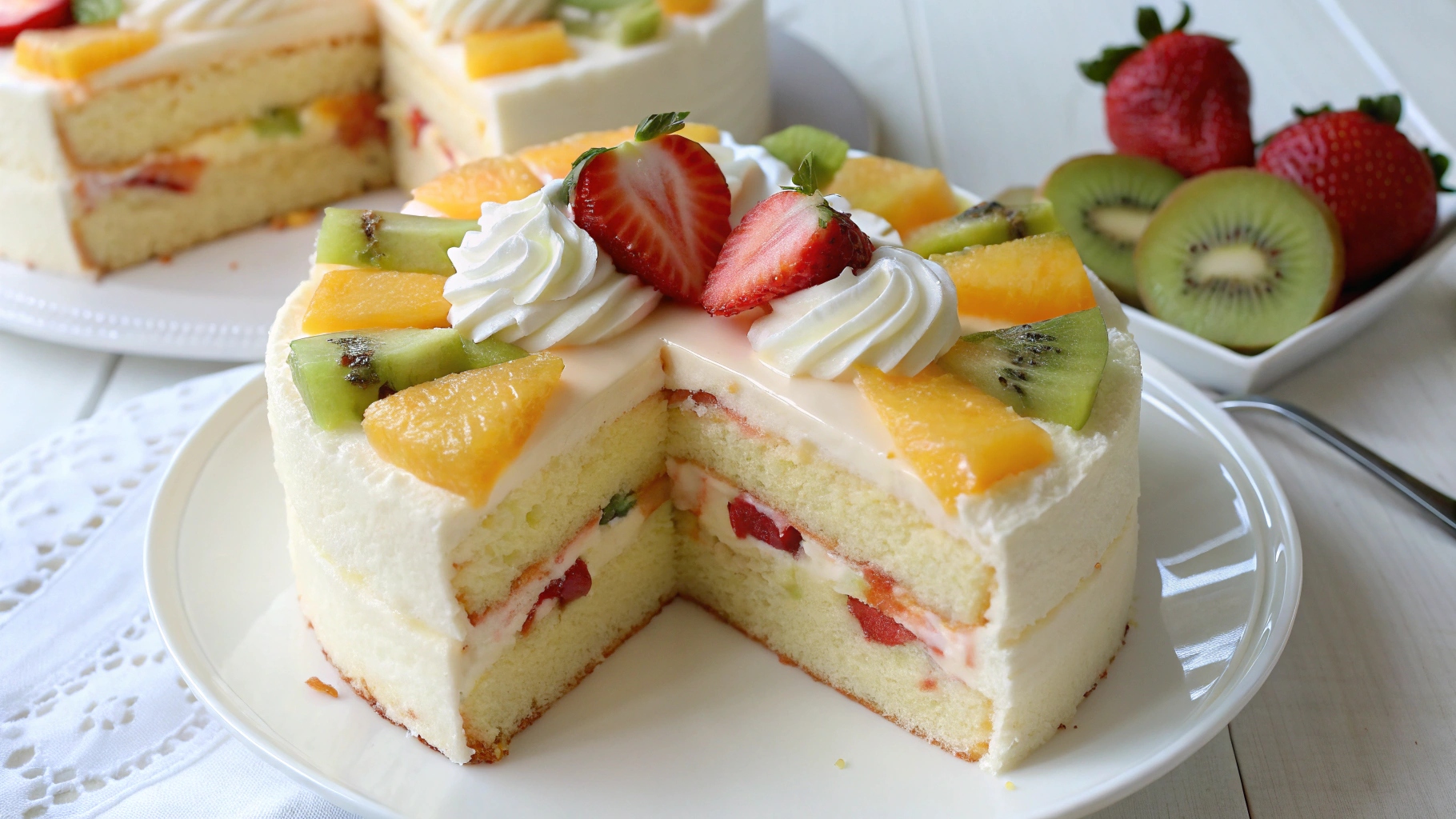PART 1: Introduction to Chinese Bakery Fruit Sponge Cake
What Makes a Chinese Bakery Fruit Sponge Cake Unique?
Unlike dense Western-style cakes, a Chinese bakery fruit sponge cake stands out for its exceptionally light and fluffy texture. It’s not overly sweet and carries a delicate balance of flavors—subtle vanilla or almond in the sponge, airy whipped cream instead of buttercream, and vibrant slices of fresh fruit layered throughout.
The texture is often described as a cross between chiffon cake and Japanese castella, which means it’s tender but springy. What really sets this cake apart is how it feels almost weightless on your fork. It’s made to melt in your mouth, not sit heavy in your stomach. That’s why it’s such a staple for birthdays and celebrations across many Chinese families.
In terms of appearance, these cakes are minimalist yet elegant. Picture soft white sponge layers, frosted with lightly sweetened whipped cream, and decorated with fresh kiwi, strawberries, mangoes, or even dragon fruit. They’re simple but stunning—and taste just as fresh as they look.
The Cultural Roots Behind This Light and Fluffy Cake
The Chinese bakery fruit sponge cake reflects a culinary fusion of Eastern and Western baking traditions. Influenced by French patisserie and Japanese light cakes, Chinese bakeries developed their own take—focused on subtlety, airiness, and freshness.
Historically, these cakes became widely popular in Hong Kong in the mid-20th century and quickly spread across East and Southeast Asia, before becoming a beloved staple in Chinese-American communities. Their popularity grew with the rise of Chinese bakeries in cities like San Francisco, Los Angeles, and New York.
Today, it’s more than just a dessert—it’s a celebration of taste and tradition. Families gather around these cakes for birthdays, Lunar New Year, and weddings. The lightness of the sponge also symbolizes good fortune and longevity in Chinese culture.
PART 2: Essential Ingredients for an Authentic Chinese Fruit Sponge Cake Recipe
Must-Have Traditional Ingredients (Cake Flour, Fresh Fruits, Cream, etc.)
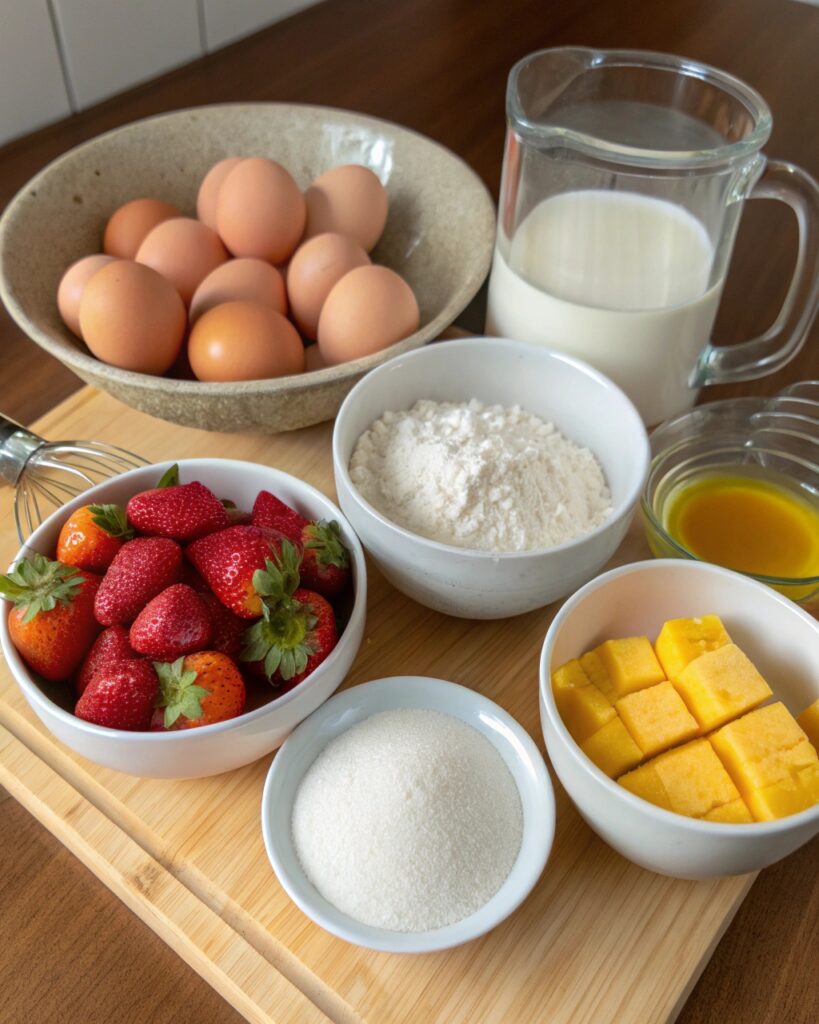
To get that signature airy and delicate texture of a Chinese bakery fruit sponge cake, it all starts with the right ingredients. Each one plays a key role in achieving the cake’s lightness, subtle sweetness, and overall balance.
Print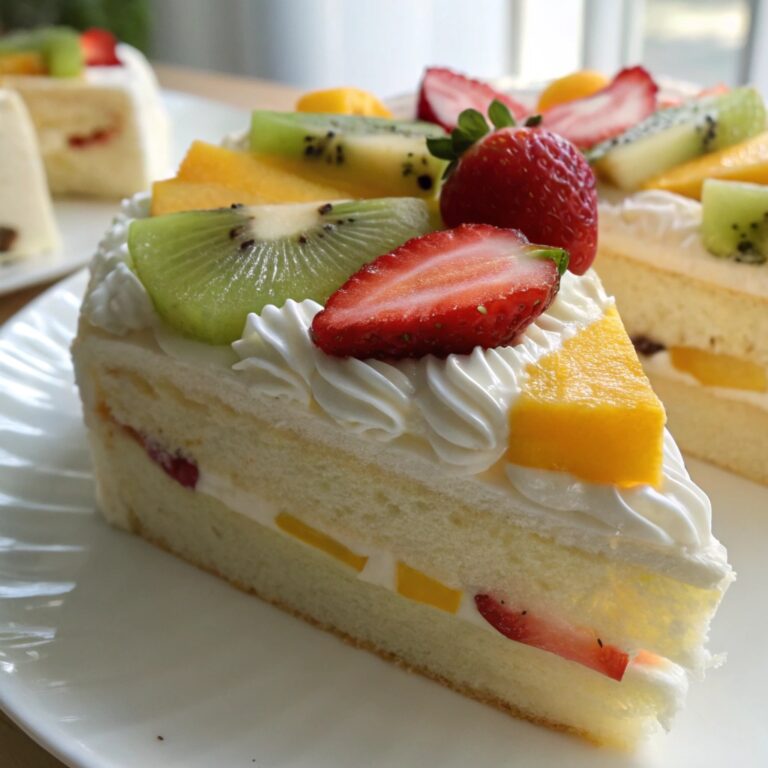
Chinese bakery fruit sponge cake recipe
A light, fluffy Chinese sponge cake layered with whipped cream and fresh fruit—just like the ones from your favorite Asian bakery. Perfect for birthdays, tea time, or celebrations.
- Total Time: 1 hour 10 minutes
- Yield: 8 servings
Ingredients
- Sponge Cake:
-
5 large eggs, separated
-
½ cup cake flour
-
½ cup granulated sugar (divided)
-
¼ cup whole milk
-
¼ cup vegetable oil
-
1 tsp vanilla extract
-
- Whipped Cream Frosting:
-
1 cup heavy whipping cream
-
3 tbsp powdered sugar
-
½ tsp vanilla extract
-
- Fruits for Filling/Topping:
-
1 cup mixed fresh fruits (strawberries, kiwi, mango)
-
Instructions
-
Prep: Preheat oven to 325°F (163°C). Line bottom of an 8-inch round pan with parchment (do not grease sides).
-
Make yolk batter: In a bowl, whisk egg yolks, half the sugar, milk, oil, and vanilla. Sift in flour and mix until smooth.
-
Make meringue: Beat egg whites with remaining sugar until stiff peaks form.
-
Fold: Gently fold egg whites into yolk mixture in 3 parts.
-
Bake: Pour batter into pan. Tap gently to release air bubbles. Bake in a water bath for 40–45 minutes.
-
Cool: Invert cake and let cool upside down. Remove from pan once cooled.
-
Whip cream: Beat heavy cream, powdered sugar, and vanilla to stiff peaks.
-
Assemble: Slice cake into layers. Spread whipped cream and fruit between layers. Frost the outside and top with remaining fruit.
-
Chill: Refrigerate 1–2 hours before serving for best texture.
Notes
-
Make sure eggs are at room temperature for best volume.
-
Use firm, dry fruits to prevent bleeding or sinking.
-
Add ½ tsp unflavored gelatin to stabilize whipped cream in warm weather.
- Prep Time: 25 minutes
- Cook Time: 45 minutes
- Category: Dessert
- Method: Baking
- Cuisine: Chinese
Nutrition
- Serving Size: 1 slice (1/8 of cake)
- Calories: 270
- Sugar: 14g
- Sodium: 50mg
- Fat: 16g
- Saturated Fat: 8g
- Unsaturated Fat: 6g
- Trans Fat: 0g
- Carbohydrates: 25g
- Fiber: 1g
- Protein: 5g
- Cholesterol: 95mg
Keywords: Chinese bakery fruit sponge cake recipe , Asian sponge cake , fluffy cake , whipped cream cake
Don’t miss our Easy Sesame Peanut Tossed Noodles
PART 3: Step-by-Step Guide to Making a Fluffy Chinese Bakery Sponge Cake
Preparing the Perfect Sponge Base with Proper Techniques
Making the sponge base is the most critical step. This is where fluffiness is born—or lost. The goal here is to create a batter that’s airy, light, and stable enough to hold its shape without deflating in the oven.
Step-by-step sponge base preparation:
- Separate your eggs
Start by separating egg whites and yolks. Use room temperature eggs—they whip better and hold more volume. - Make the yolk batter
In a bowl, whisk egg yolks, sugar (half the total), vegetable oil, milk, and vanilla extract. Then sift in cake flour and mix gently until smooth. Avoid overmixing—it can lead to a dense cake. - Whip egg whites to stiff peaks
In a clean, dry bowl, whip egg whites with the remaining sugar. Use an electric mixer on medium-high. You’ll know you’ve reached stiff peaks when the whites stand upright without drooping when the beater is lifted. - Fold egg whites into yolk mixture
Gently fold in the whipped egg whites in thirds. Use a rubber spatula and light, circular motions from the bottom up. This preserves the air you’ve whipped in. - Pour into prepared pan
Use an ungreased 8-inch round pan lined with parchment paper. The batter needs to cling to the sides to rise properly. - Bake using the water bath method
Bake at 325°F (163°C) in a water bath. This method adds moisture to the oven, prevents cracks, and gives the sponge its signature smooth top. - Cool upside-down
Flip the cake over immediately after baking and cool upside down to prevent it from collapsing.
Beating Egg Whites and Creating an Airy Texture
If you’re aiming for that bakery-style puffiness, mastering the art of whipping and folding egg whites is non-negotiable.
Tips for perfect meringue:
- Use a clean, oil-free bowl—Even the tiniest bit of fat can ruin your peaks.
- Add sugar gradually—Once the egg whites start to foam, begin adding sugar one tablespoon at a time.
- Don’t overwhip—Stiff peaks should still look glossy. If the egg whites look dry or clumpy, they’re overdone.
Once folded in, the whipped egg whites give the sponge structure and bounce. This method is what separates a regular cake from the cloud-like delight of a Chinese bakery sponge cake.
PART 4: Decorating the Chinese Fruit Sponge Cake Like a Pro
How to Layer and Frost the Cake Chinese-Style
Now that your sponge is baked to soft, golden perfection, it’s time to give your cake that Chinese bakery look—clean, elegant, and bursting with fresh fruit.
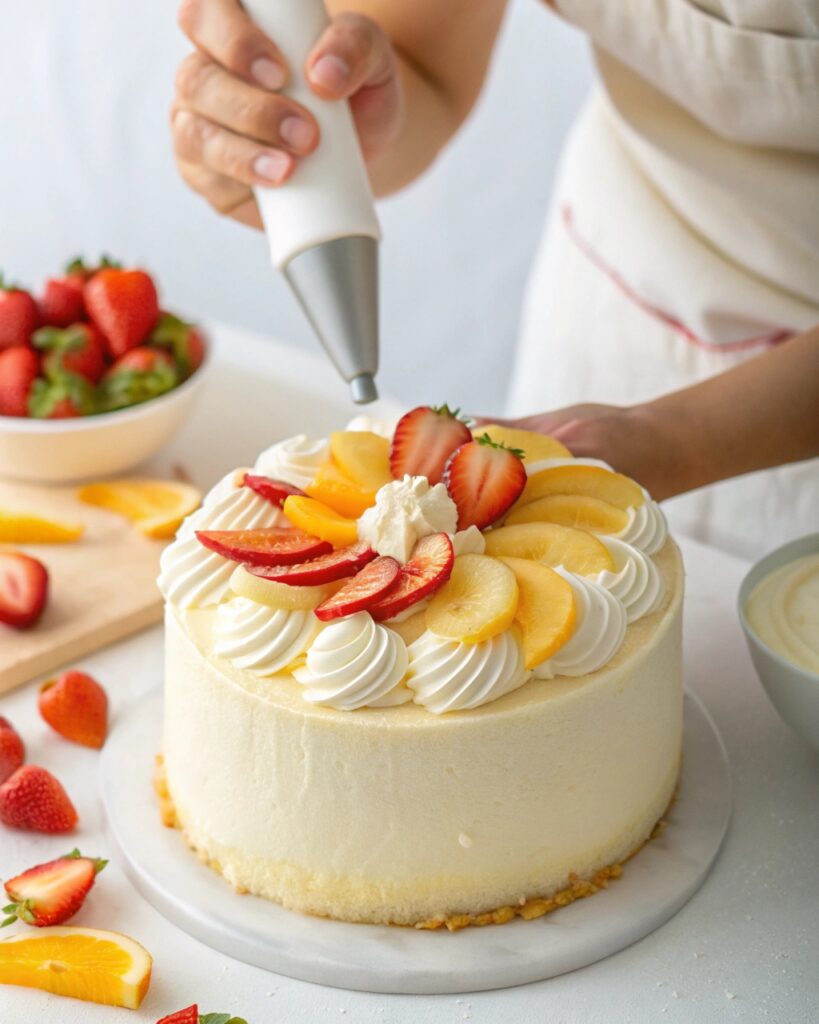
Step-by-step Chinese-style decorating:
- Slice the cake into layers
Once completely cooled, slice your sponge horizontally into two or three even layers using a serrated knife. If the cake has domed on top, level it for smooth stacking. - Prepare the whipped cream frosting
In a chilled bowl, whip heavy cream with powdered sugar and a few drops of vanilla extract. Beat until stiff peaks form. If you’re decorating in warm weather, add a bit of stabilizer (like cornstarch or gelatin) to help hold its shape. - Frost the inner layers
Place the first sponge layer on a cake board. Spread a generous layer of whipped cream and top it with sliced fruit—strawberries, peaches, or mangoes are popular choices. - Stack and crumb-coat
Add the next layer and repeat. Once stacked, apply a thin crumb coat (a light layer of cream) to seal in the crumbs. Chill for 15 minutes. - Final frosting layer
After chilling, apply the final layer of whipped cream. Smooth it out with an offset spatula for that minimalist bakery finish. - Optional piping and detail
Use a star tip and piping bag to add borders or swirls. Keep it subtle—Chinese bakery cakes are known for their understated beauty.
Adding Fresh Fruits Without Sinking or Bleeding
Decorating with fresh fruit isn’t just about beauty—it’s about getting that clean, juicy finish without your fruit sinking into the sponge or leaking juice into the cream.
Top fruit decorating tips:
- Choose firm, ripe fruit – Avoid overripe fruit that leaks too much juice.
- Slice fruits thinly and evenly – Thick pieces are more likely to weigh down the sponge.
- Dry fruit before placing – Pat fruit slices dry with a paper towel to prevent bleeding into the whipped cream.
- Glaze for shine – Lightly brush fruit with a glaze made of warmed apricot jam or gelatin to add shine and preserve freshness.
Popular fruit choices for topping include:
| Fruit | Flavor Profile | Color Accent |
|---|---|---|
| Kiwi | Tart and refreshing | Green |
| Strawberries | Sweet and juicy | Red |
| Mango | Rich and smooth | Yellow/Orange |
| Blueberries | Mild and sweet | Blue/Purple |
| Peaches | Soft and floral | Pale orange |
PART 5: Tips and Techniques for Achieving Bakery-Level Softness
The Role of Temperature and Mixing Techniques
If you’ve ever wondered how Chinese bakeries get their cakes so incredibly soft and pillowy, it’s not just the ingredients—it’s how you treat them. Temperature and mixing methods play a huge role in creating that feather-light sponge texture.
Key temperature tips:
- Room temperature eggs and milk are essential. Cold ingredients will cause the batter to curdle or collapse.
- Warm your mixing bowl slightly before whipping egg whites—this helps speed up the process and improves volume.
- Oven temperature consistency is non-negotiable. Too hot, and the cake will dome and crack. Too low, and it’ll be dense or sink.
Use an oven thermometer to ensure you’re actually baking at 325°F (163°C). Most home ovens are off by 10–15 degrees.
Smart mixing techniques:
- Don’t overmix your yolk batter—once the flour is in, mix just until combined.
- Fold gently and slowly when incorporating egg whites. The motion should be circular, lifting from the bottom, not stirring.
- Tap the pan lightly on the counter before baking to release large air bubbles, which can create holes.
Common Mistakes to Avoid When Making a Sponge Cake
Even small mistakes can keep your cake from reaching that soft, bakery-level texture. Avoid these common pitfalls:
Mistake 1: Overbeating egg whites
Overbeaten whites turn grainy and break when folded, deflating the batter. Stop at glossy stiff peaks.
Mistake 2: Greasing the pan
Sponge cakes need to cling to the pan sides to rise properly. Use parchment paper on the bottom only.
Mistake 3: Opening the oven early
This drops the oven temp quickly and can collapse your cake. Don’t peek until at least 30 minutes in.
Mistake 4: Not cooling upside down
Especially with chiffon-style sponges, cooling upside down prevents collapse and maintains structure.
Mistake 5: Using the wrong flour
All-purpose flour creates a dense, chewy sponge. Stick to cake flour or make your own substitute (1 cup AP flour minus 2 tbsp, plus 2 tbsp cornstarch).
PART 6: Flavor Variations of Chinese Bakery Fruit Cakes
Popular Regional Flavors (Matcha, Mango, Taro, etc.)
While the classic Chinese bakery fruit sponge cake is usually vanilla-flavored with whipped cream and assorted fruits, regional variations across Asia have brought exciting twists to this beloved treat. These flavors not only add character but also showcase the fusion of East Asian taste profiles.
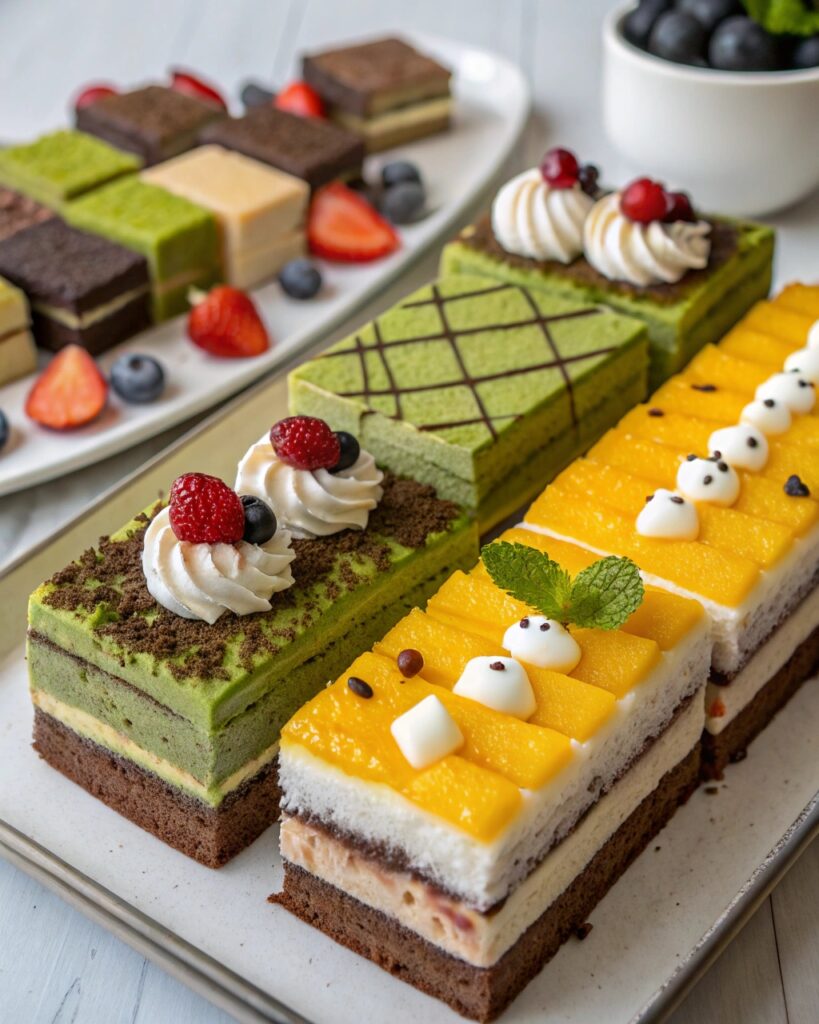
Matcha (Green Tea)
Originating from Japan but widely used in Chinese baking, matcha gives the sponge a slightly bitter yet earthy flavor that pairs beautifully with strawberries or red bean paste. The green hue also adds a stunning visual.
Mango
This tropical twist is a fan favorite in Hong Kong bakeries. Layers of sponge are filled with whipped cream and fresh mango chunks or mango puree for a rich, juicy finish.
Taro
Purple taro paste adds a nutty, subtly sweet taste to the cake. It’s often used between layers or swirled into the whipped cream frosting for a beautiful marbled look.
Black Sesame
For a deeper, roasted flavor, black sesame powder or paste can be added to the sponge or cream. It’s a popular choice for adults who prefer less sweet desserts.
Coffee or Mocha
This variation is often seen in Taiwanese-style bakeries. The sponge is infused with espresso, and the cream might have a mocha flavor, sometimes with chocolate shavings on top.
Modern Twists and Fusion-Inspired Versions
As Chinese bakeries evolve globally, they’re embracing new ingredients and techniques. Whether you’re baking at home or visiting a trendy urban bakery, you’ll find bold flavor combinations that marry tradition with innovation.
Strawberry Shortcake Style
Inspired by Japanese patisserie, this version uses extra-light sponge, loads of whipped cream, and juicy strawberry halves—sometimes even stacked tall like a layer tower.
Lychee and Rose
A delicate floral-fruit combo. Rose-flavored sponge or cream is paired with sweet lychee chunks. It’s often used for special occasions or weddings due to its romantic look and scent.
Chocolate Fruit Cake
Not traditional, but now widely embraced. Chocolate sponge layered with cream and mixed berries creates a crowd-pleaser with rich flavor and balance.
Durian Cream
A bold Southeast Asian fusion. The whipped cream is blended with durian puree for a powerful flavor that durian lovers crave.
Earl Grey and Blueberry
Infuse the sponge with earl grey tea, then add blueberry jam or whole berries to the cream layers. It’s fragrant, elegant, and perfect for tea-time occasions.
PART 7: Storing and Serving Your Fruit Sponge Cake
Best Storage Practices to Keep the Cake Moist
You’ve baked and decorated your beautiful Chinese bakery fruit sponge cake—now the question is how to keep it fresh, soft, and delicious for as long as possible. Proper storage is key to preserving both the texture of the sponge and the freshness of the fruit and cream.
Short-Term Storage (Same Day or Overnight):
- Refrigerate in an airtight container: If serving within 24 hours, place the cake in a covered cake container or gently wrap it with plastic wrap. This protects it from drying out and absorbing fridge odors.
- Store at the bottom shelf of the fridge: It’s cooler and more temperature-stable than the top.
- Avoid overly cold temperatures: Extremely cold air can harden the sponge and make the whipped cream stiff or dry.
Long-Term Storage (2–3 Days Max):
- Remove fruits before freezing (if needed): If you plan to freeze slices, take off the fresh fruit toppings first, as they’ll become mushy.
- Wrap slices individually: For freezing, use cling film and a layer of foil. Thaw in the fridge overnight before serving.
- Don’t freeze whole decorated cakes: Whipped cream and fruit don’t freeze well together.
How to Plate and Serve Like an Asian Bakery
Presentation matters—especially with such a visually elegant dessert. Here’s how to serve your cake to wow your guests, bakery-style.
Serving tips:
- Use a warm knife for clean slices: Dip the knife in hot water and wipe dry before each cut. This helps prevent cream and fruit from smearing.
- Plate with a fruit garnish: Add a few matching fresh fruit slices or mint sprigs to each plate for extra flair.
- Serve chilled but not cold: Take the cake out of the fridge 15 minutes before serving. This brings out the best texture and flavor.
- Pair with light drinks: Jasmine tea, oolong, or even sparkling water with lemon enhances the delicate taste of the cake.
| Serving Idea | Presentation Tip |
|---|---|
| Mini slices for tea time | Serve on dainty plates with a fork and a teacup |
| Full-size birthday cake | Use a rotating cake stand and add candles with height |
| Slice with fresh cream dollop | Pipe a swirl of extra whipped cream next to the slice |
PART 8: FAQ Section
How are Chinese cakes so fluffy?
Chinese cakes are fluffy due to whipped egg whites, cake flour, and vegetable oil. Folding egg whites gently into the yolk batter traps air, creating that cloud-like texture. Baking in a water bath adds moisture and prevents cracking.
What is the secret to a good sponge cake?
The key is technique: use room-temperature eggs, whip whites to stiff peaks, fold gently, sift dry ingredients, and bake at a steady, accurate temperature. This ensures a light, even, bakery-style sponge.
How do you keep fruit from sinking in a sponge cake?
Dry fruit well, cut it small, and coat it in flour before adding it to the batter. Use a thicker sponge base and layer fruit carefully—ideally in the filling or as topping after baking.
How do you know when a rich fruit cake is cooked?
Check for golden edges, a springy top, and a clean toothpick. A finished cake also stops making bubbling sounds. For denser cakes, baking takes longer, and the surface should be firm.
PART 9: Conclusion and More Recipes to Explore
Crafting the perfect Chinese bakery fruit sponge cake recipe at home isn’t just about baking—it’s about capturing a cultural classic that’s light, fresh, and full of joy. From preparing the perfect sponge base to artfully layering whipped cream and fruits, you now have the tools to recreate this beloved dessert with bakery-level finesse.
This cake isn’t just for birthdays—it’s perfect for tea time, weekend treats, or anytime you want to impress without overwhelming. With so many flavor variations, from mango and taro to matcha and lychee, you’ll never run out of ways to make this recipe your own.
Whether you stick with the traditional approach or try a bold, modern twist, the key lies in mastering the small details: whipping egg whites just right, folding gently, and decorating with care. Once you’ve baked this cake once, you’ll understand why it’s become a staple in Chinese-American celebrations—and you’ll want to bake it again and again.

